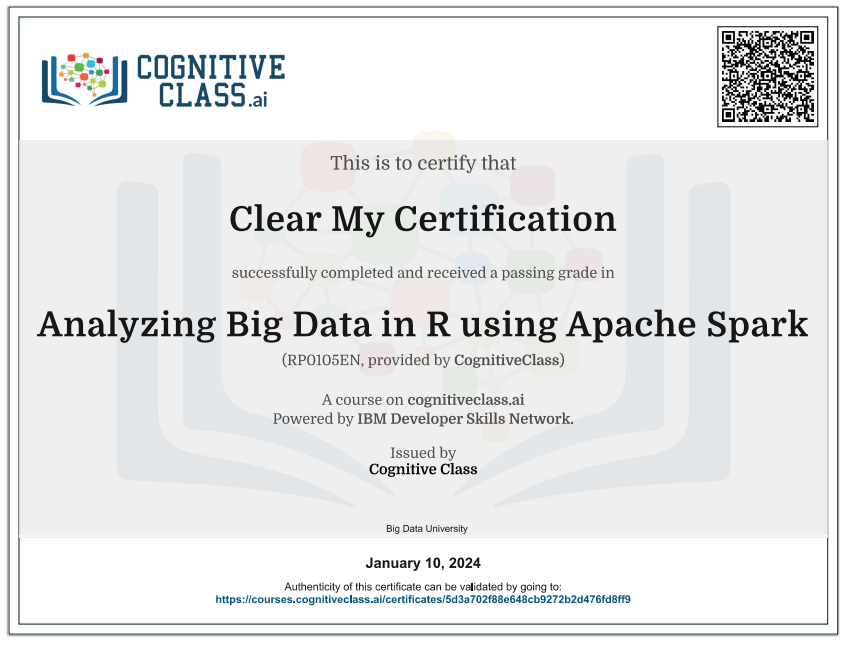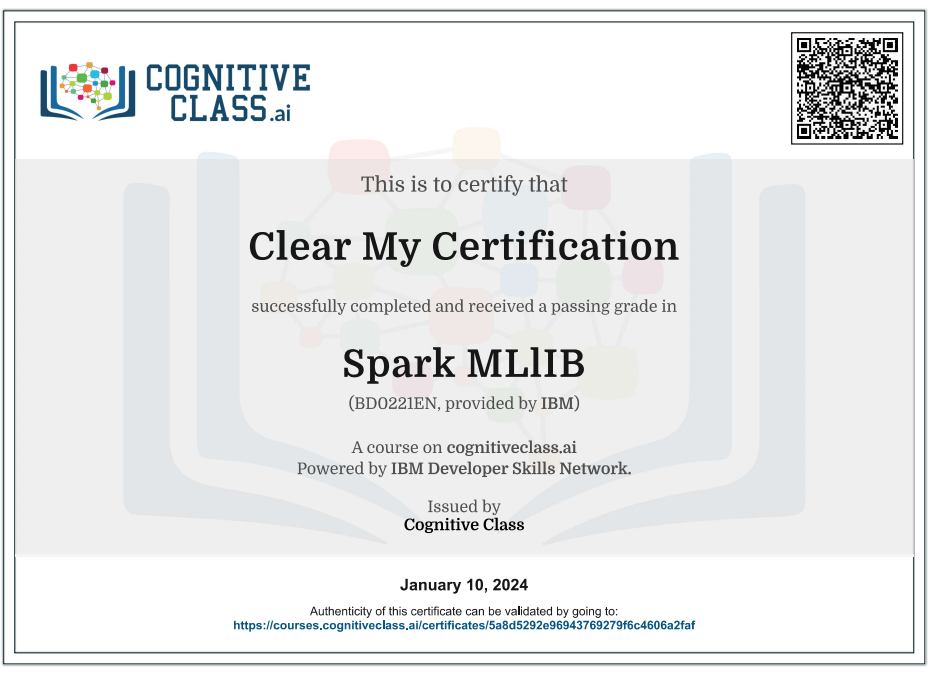Enroll Here: Deep Learning Fundamentals Cognitive Class Exam Quiz Answers
Deep Learning Fundamentals Cognitive Class Certification Answers

Module 1: Introduction to Deep Learning Quiz Answers – Cognitive Class
Question 1: Select the reason(s) for using a Deep Neural Network
- Some patterns are very complex and can’t be deciphered precisely by alternate means
- Deep Nets are great at recognizing patterns and using them as building blocks in deciphering inputs
- We finally have the technology – GPUs – to accelerate the training process by several folds of magnitude
- All of the above
Question 2: What is TRUE about the functions of a Multi-Layer Perceptron?
- The first neural nets that were born out of the need to address the inaccuracy of an early classifier, the perceptron.
- It predicts which group a given set of inputs falls into.
- It generates a score that determines the confidence level of the prediction.
- All of above.
Question 3: Why is the vanishing gradient a problem?
- Training is quick if the gradient is large and slow if its small
- With backprop, the gradient becomes smaller as it works back through the net
- The gradient is calculated multiplying two numbers between 0 and 1
- All of above.
Module 2: Deep Learning Models Quiz Answers – Cognitive Class
Question 1: For Unsupervised Learning, which of the following deep nets would you choose?
- Autoencoder or Restricted Boltzmann Machines
- Deep Belief Nets
- Convolutional Nets
- Recurrent Nets
Question 2: True or False: The RELU activation has no effect on back-propagation and the vanishing gradient
- True
- False
Question 3: True or False: Convolutional Nets are the right model when dealing with data that changes over time because of their built-in feedback loop, allowing them to serve as a forecasting engine.
- True
- False
Module 3: Additional Deep Learning Models Quiz Answers – Cognitive Class
Question 1: Which of the following are use cases of Deep nets?
- Sentiment Analysis of text data.
- Offering personalized ads based on user activity history.
- Flagging a transaction as fraudulent.
- Analyze and segment customers based on digital activity and footprint.
- Using satellite feeds and sensor data to detect changes in environmental conditions.
- All of the above.
Question 2: Which of the following are use cases of machine vision. Select all that apply.
- Image classification and tagging
- Sentiment Analysis
- Face Detection
- Video Recognition
- Speech Recognition
Question 3: Which of the following is a good application of an RNTN?
- If the patterns change through time
- For general classification problems
- If there is an unknown hierarchy inherent in the input features
- For Supervised Fine-tuning
- To determine the relative importance in the input features
Module 4: Deep Learning Platforms & Libraries Quiz Answers – Cognitive Class
Question 1: Which of the following is not an aspect of a deep net platform?
- Choice of deep net models
- Ability to integrate data from multiple sources
- Manage deep net models from the UI
- Under the hood performance enhancements to allow for fast training and execution
- Deriving the optimal hyper-parameter configuration
Question 2: What are the different aspects of a Deep Learning Library?
- They are a set of pre-built functions and modules that you can call through your own programs
- Usually maintained by high-performance teams and are regularly updated
- Most are open source and have a large community that contribute to the code base
- All of above.
Question 3: True or False: Theano, Caffe, and TensorFlow are examples of deep learning platforms.
- True
- False
Deep Learning Fundamentals Final Exam Answers – Cognitive Class
Question 1: For supervised learning, which of the following deep nets would you choose?
- Autoencoder
- Deep Belief Nets
- Convolutional Nets
- Restricted Boltzmann Machines
- Recurrent Nets
Question 2: Which of the following is true with respect to the training process of a deep net?
- The Cost is the difference between the net’s predicted and actual outputs.
- The training process utilizes gradients which measure the rate at which the weights and biases change with respect to the cost.
- The objective of the training process is to make the cost as low as possible.
- The training process utilizes a technique called back-propagation.
- All of above.
Question 3: True or False: With backprop, the early layers train slower than the later ones, making the early layers incapable of accurately identifying the pattern building blocks needed to decipher the full pattern.
- True
- False
Question 4: For image recognition, which of the following deep nets would you choose? Select all that apply.
- Autoencoder
- Deep Belief Nets
- Convolutional Nets
- Restricted Boltzmann Machines
- Recurrent Nets
Question 5: How does the Deep Belief Network (DBN) solve the vanishing gradient? Select all that apply.
- It uses a stack of RBMs to determine the initial weights and biases, where the output of any RBM forms the input to the next RBM.
- It uses a small labelled data set to associate patterns learned by the RBMs to classes.
- It utilizes supervised fine-tuning, resulting in tweaks in weights and biases and a slight improvement in accuracy.
- It quickly moves through solution states – set of weights and biases – going from one to another based on a reward.
- The complete process – RBMs for pre-training and supervised fine-tuning – results in a very accurate net which trains in an acceptable time.
Question 6: True or False: To train, a DBN combines two Learning methods – supervised and unsupervised.
- True
- False
Question 7: Which of the following is the most popular use of a Convolutional Net?
- Image Recognition
- Object Recognition in an Image
- Time Series Forecasting
- Supervised Fine Tuning
- General classification
Question 8: Which of the following are True about RBM? Select all that apply.
- The RBM is part of the first attempt at beating the vanishing gradient and uses unlabelled data.
- It improves its own accuracy through self-correction.
- Its purpose is to re-create inputs and in doing so has to make decisions about which input features are more important.
- It stores the relative importance of the features as weights and biases.
- It predicts which group a given set of inputs falls into.
Question 9: Which of the following statements are true about the architecture of a CNN? Select all that apply.
- A CNN can only have two types of layers: CONV and RELU.
- A RELU layer has to always be followed by a POOL layer.
- FC layers are usually found at the end.
- A CONV layer has a theoretical maximum number of filters.
- A typical CNN implementation has multiple repetitions of CONV, RELU and POOL layers, with sub-repetitions.
Question 10: True or False: By definition, the classifier in the nodes of an MLP cannot be anything other than the Perceptron.
- True
- False
Question 11: Which of the following are differences between a Recurrent Net and a Feedforward Net? Select all that apply.
- Recurrent Nets feed the output of any time step back in as input for the next step.
- Recurrent Nets are used for time series forecasting.
- Recurrent Nets can output a sequence of values.
- Recurrent Nets are trained using back-propagation.
- The nodes in recurrent nets have a classifier that activate and produce a score.
Question 12: Which of the following statements are true about training a Recurrent Net? Select all that apply.
- Since RNNs use backprop, the vanishing gradient is a problem.
- The number of time steps used for training has no bearing on the severity of the vanishing gradient problem.
- The vanishing gradient can potentially lead to decay of information through time.
- The most popular technique to address the vanishing gradient is the use of gates.
- The only technique to address the vanishing gradient is the use of gates.
Question 13: True or False: Deep Autoencoders are used for dimensionality reduction.
- True
- False
Question 14: Which of the following are true about Autoencoders? Select all that apply.
- It improves its own accuracy through self-correction.
- Its purpose is to re-create inputs and in doing so has to make decisions about which input features are more important.
- A Restricted Boltzmann Machine is a type of Autoencoders.
- It stores the relative importance of the features as weights and biases.
- It predicts which group a given set of inputs falls into.
Question 15: True or False: Given they are mainly about machine vision; Convolutional Nets don’t really find a home in the field of medicine.
- True
- False
Introduction to Deep Learning Fundamentals
Deep learning is a subfield of machine learning that focuses on neural networks with multiple layers, known as deep neural networks. These networks are capable of learning hierarchical representations of data, enabling them to perform complex tasks such as image and speech recognition, natural language processing, and more. Here are some fundamental concepts in deep learning:
- Neural Networks: Neural networks are the foundation of deep learning. They are composed of interconnected nodes organized into layers. The input layer receives data, the hidden layers process information, and the output layer produces the final result. Deep neural networks have multiple hidden layers, distinguishing them from shallow networks.
- Activation Functions: Activation functions introduce non-linearity to the neural network, allowing it to learn complex patterns. Common activation functions include ReLU (Rectified Linear Unit), Sigmoid, and Tanh.
- Backpropagation: Backpropagation is the training algorithm used to adjust the weights of the neural network based on the error between predicted and actual outcomes. It involves propagating the error backward through the network and updating weights using optimization techniques like gradient descent.
- Gradient Descent: Gradient descent is an optimization algorithm used to minimize the loss function during training. It adjusts the model parameters in the direction that reduces the error.
- Loss Function: The loss function measures the difference between the predicted output and the actual target. The goal during training is to minimize this loss. Common loss functions include Mean Squared Error (MSE) for regression tasks and Cross-Entropy Loss for classification tasks.
- Deep Learning Architectures: Various deep learning architectures exist for different tasks. Convolutional Neural Networks (CNNs) are commonly used for image recognition, Recurrent Neural Networks (RNNs) for sequential data like time series or natural language, and Transformers for natural language processing tasks.
- Transfer Learning: Transfer learning involves using pre-trained models on large datasets for specific tasks. This helps leverage knowledge gained from one task to improve performance on a different, but related, task.
- Autoencoders: Autoencoders are neural networks designed for unsupervised learning. They consist of an encoder that compresses input data into a latent space representation and a decoder that reconstructs the input from this representation.
- Dropout: Dropout is a regularization technique used to prevent overfitting. It randomly drops a subset of neurons during training, forcing the network to learn more robust features.
- Batch Normalization: Batch normalization is a technique that normalizes the inputs of a layer to stabilize and accelerate training. It helps in mitigating the vanishing or exploding gradient problem.
- Recurrent Neural Networks (RNNs) and Long Short-Term Memory (LSTM): RNNs are designed for sequential data, and LSTMs are a type of RNN that helps address the vanishing gradient problem by maintaining a memory cell.
Deep learning has demonstrated remarkable success in various applications, including computer vision, natural language processing, speech recognition, and game playing. As technology advances, deep learning continues to play a pivotal role in shaping the future of artificial intelligence.
 Clear My Certification All Certification Exam Answers
Clear My Certification All Certification Exam Answers



